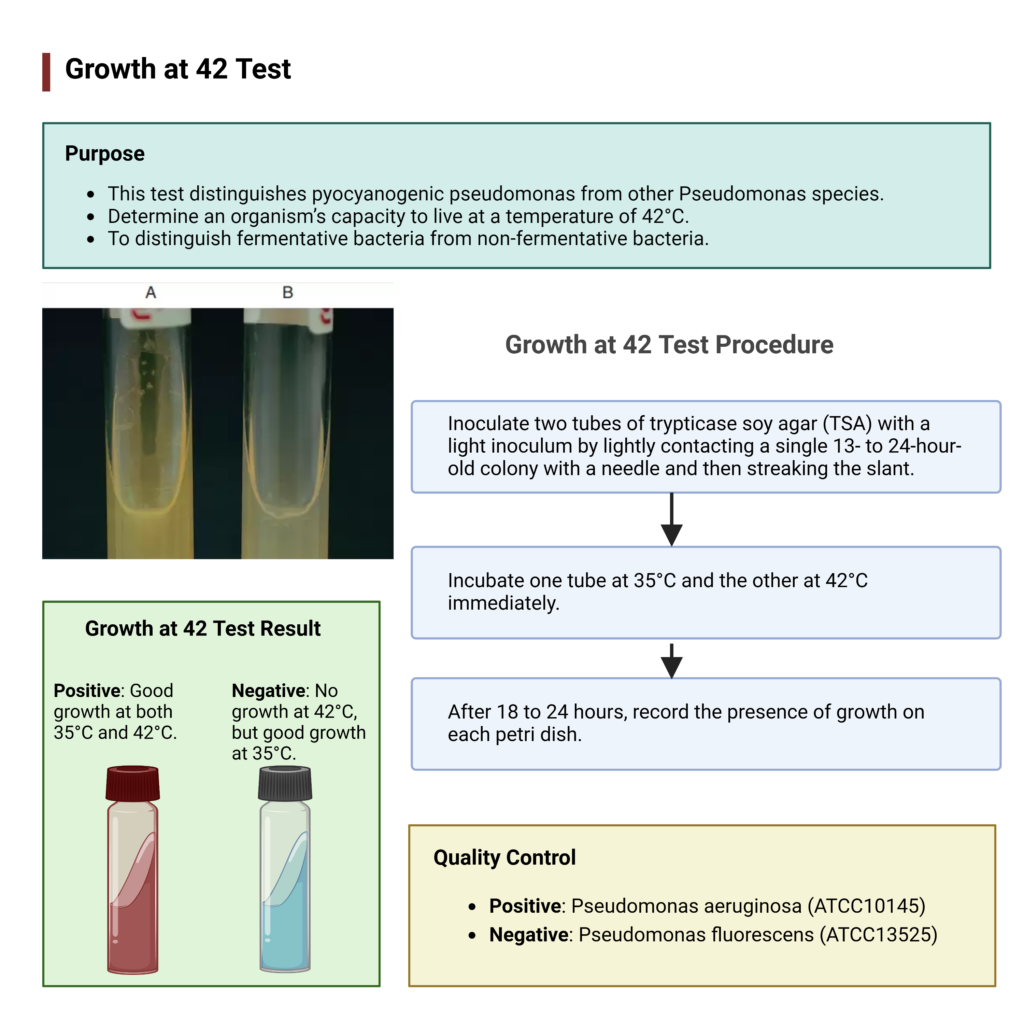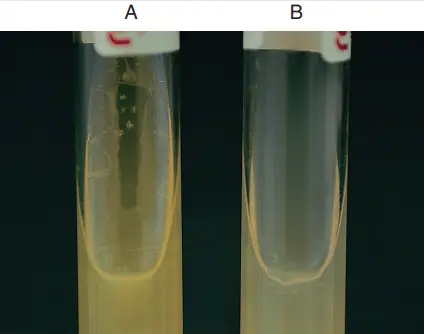Table of Contents
| Test Name | Growth at 42 Test |
| Purpose | This test distinguishes pyocyanogenic pseudomonas from other Pseudomonas species. Determine an organism’s capacity to live at a temperature of 42°C. To distinguish fermentative bacteria from non-fermentative bacteria. |
| Uses | The test is used to determine an organism’s capacity to grow at 42°C. This test distinguishes pyocyanogenic pseudomonas from other Pseudomonas species. |
| Result | Positive: Good growth at both 35°C and 42°C. Negative: No growth at 42°C, but good growth at 35°C. |
| Require | Tryptic Soya Agar |
| Quality Control | Positive: Pseudomonas aeruginosa (ATCC10145) Negative: Pseudomonas fluorescens (ATCC13525) |
- It is recommended that species of the luminous pseudomonas group as well as other non-fermentative bacteria be grown at 42°C.
- Due to the severity of P. aeruginosa-caused infections, it is clinically vital to distinguish apyocyanogenic Pseudomonas aeruginosa from other luminous pseudomonads.
- Tests performed on both groups included oxidation of potassium gluconate and tolerance to cetrimide, whereas tests used to distinguish between the two groups included flagella arrangements, gelatin liquefaction, slime production, lecithinase activity, peptonization of litmus milk, and other less reliable characteristics.
- Historically, growth at 42’C has been regarded as a crucial test for distinguishing nonpigmented P. aeruginosa from other fluorescent pseudomonad species.
- Introduction of commercial test systems (Oxi/ Ferm, API 20-E, and Corning N/F test systems) for identification of non-fermentative bacteria (NFB) has rekindled interest in the routine identification of these organisms with greater accuracy.
- The use of these technologies has necessitated that laboratories conduct temperature growth studies as an additional battery of tests for identification.
- Recent research indicates that acetamide usage correlates well with identification of P. aeruginosa; however, direct investigations correlating acetamide utilization and growth at 42°C have not been conducted. Consequently, a reexamination of the growth test’s results seemed appropriate.

Purpose of Growth at 42 Test
- This test distinguishes pyocyanogenic pseudomonas from other Pseudomonas species.
- Determine an organism’s capacity to live at a temperature of 42°C.
- To distinguish fermentative bacteria from non-fermentative bacteria.
Principle of Growth at 42°C Test
- Pseudomonas aeruginosa is a Gram-negative, rod-shaped, asporogenous, and single-flagged bacterium.
- It has a pearlescent appearance and smells like grapes or tortillas. P. aeruginosa thrives in temperatures ranging from 25 C to 37 C, and its capacity to grow at 42 C distinguishes it from the majority of other Pseudomonas species.
- P. aeruginosa is a pervasive microbe that can live in a wide range of environmental circumstances.
- It causes disease not only in plants and animals, but also in people, producing severe infections in immunocompromised cancer patients and individuals with severe burns and cystic fibrosis (CF).
- During this evaluation, 3 ml of Trypticase soy broth was inoculated with a loopful of a broth culture grown overnight. After 24 and 48 hours of incubation at 41.5 0.50°C, the growth in the 42°C tube was deemed moderate or minor.
- Pseudomonas aeruginosa proliferated abundantly following an overnight incubation, but 16 of 74 P. putida isolates (22%) exhibited mild turbidity in the broth after 24 or 48 hours, which could not be attributed to an inoculum effect.
- Using both Trypticase soy agar and Trypticase soy broth, the growth was again evaluated as heavy or light.
- P. putida continued to grow on slants in certain cases (6%), despite a drop in the number of strains exhibiting growth.
- As a color indicator for growth, 0.005% triphenyltetrazolium chloride was added to the Trypticase soy broth. Although P. putida strains had apparent signs of development, there was no color change when compared to the 35°C control.
- Using nonfermentative bacteria, the consistency of test results is not only method dependent, but also strain dependent.
- Although the test for growth at 42°C is an essential taxonomic tool when applied under controlled settings, alternative assays, such as the acetamide test, are recommended for use in the clinical laboratory.
Materials
Microorganism Tested
This examination comprised isolates from recent clinical samples. Before testing at 42°C, the isolates were not subjected to recurrent cultures. Temperature-growth investigations were part of the battery of assays needed to identify each isolate definitively.
- P. alcaligenes
- P. pseudoalcaligenes
- P. putrefaciens
- P. stutzeri
Test media
- A 3-ml amount of Trypticase soy broth (TSB).
- Trypticase soy agar (TSA) as slants.
- 0.005% triphenyltetrazolium chloride (TTC) as an indicator of growth.
Note: Before inoculation, the medium were always brought to room temperature.
Tryptic Soya Agar Composition
| Ingredients | Gms / Litre |
| Tryptone | 17.000 |
| Soya peptone | 3.000 |
| Sodium chloride | 5.000 |
| Dextrose (Glucose) | 2.500 |
| Dipotassium hydrogen phosphate | 2.500 |
| Agar | 15.000 |
| Final pH ( at 25°C) | 7.3±0.2 |
Tryptic Soya Agar Preparation
- Suspend 45 grammes in 1000 cc pure / distilled water.
- To completely dissolve the medium, bring to a boil.
- Autoclave at 15 pounds pressure (121 degrees Celsius) for 15 minutes to sterilise.
- Cool to 45-50 degrees Celsius. Mix thoroughly and then pour into sterilised Petri dishes.
Procedure of Growth at 42°C Test
- Inoculate two tubes of trypticase soy agar (TSA) with a light inoculum by lightly contacting a single 13- to 24-hour-old colony with a needle and then streaking the slant.
- Incubate one tube at 35°C and the other at 42°C immediately.
- After 18 to 24 hours, record the presence of growth on each petri dish.
Result of Growth at 42°C Test
- Positive: Good growth at both 35°C and 42°C.
- Negative: No growth at 42°C, but good growth at 35°C.

Quality Control
- Positive: Pseudomonas aeruginosa (ATCC10145)
- Negative: Pseudomonas fluorescens (ATCC13525)
Limitation
- The examination is plagued with technological issues. Variables include the choice of medium, the size of the inoculum, the age of the inoculum, and maybe the incubation apparatus.
- However, the test may have a role in an exhaustive identification protocol.
- Inoculating a slanted agar medium with a loopful of an overnight broth culture and incubating the slant for 18 to 24 hours is the preferred way.
- The inconsistency of growth at the selection temperature between species severely limits the ability to distinguish closely related species. The light growth of P. putida in broth and on agar lowers the efficiency of the test when the growth or non-growth criterion is used to interpret test results.
- In addition, multiple crossings at 42C are impractical for normal use.
Uses
- The test is used to determine an organism’s capacity to grow at 42°C.
- This test distinguishes pyocyanogenic pseudomonas from other Pseudomonas species.
References
- Oberhofer TR. Growth of nonfermentative bacteria at 42 degrees C. J Clin Microbiol. 1979 Dec;10(6):800-4. doi: 10.1128/jcm.10.6.800-804.1979. PMID: 118175; PMCID: PMC273274.
- Bailey & Scott’s Diagnostic Microbiology
- Wu, W., Jin, Y., Bai, F., & Jin, S. (2015). Pseudomonas aeruginosa. Molecular Medical Microbiology, 753–767. doi:10.1016/b978-0-12-397169-2.00041-x
- https://docksci.com/growth-of-nonfermentative-bacteria-at-42-degrees-c_5d737764097c47da498b4574.html
- https://europepmc.org/article/med/118175
- https://journals.asm.org/doi/10.1128/jcm.10.6.800-804.1979
- https://microbiologyinfo.com/growth-at-42-test/
